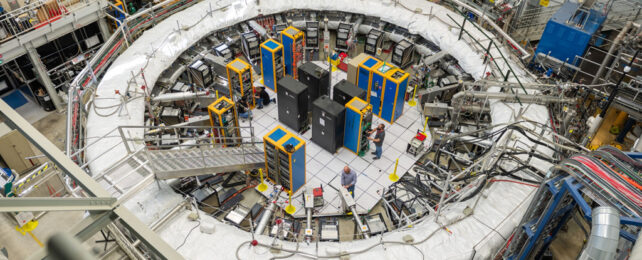Experiments on the distinctive wobble of a heavyweight cousin to the electron called the muon are repeatedly finding something isn't quite adding up, pointing the way towards unknown physics.
Nearly 20 years after researchers from Brookhaven Particle Accelerator in New York first provided evidence of an anomaly, hundreds of scientists working with the Muon g-2 Collaboration have just announced the latest measurement of the muon's motion in an electromagnetic field.
Based on a rather substantial amount of fresh data collected using the US Department of Energy's Fermi National Accelerator Laboratory, the new analysis confirms a difference between expectations and results of 116 592 055 x 10-11 .
That's a tiny number, to be sure. But it could promise some big new discoveries. And with a precision of 0.2 parts per million, the analysis could be likened to estimating the distance between two people on separate sides of the US and being out by less than a meter (a couple of feet).
"This measurement is an incredible experimental achievement," says Peter Winter, a physicist at the Argonne National Laboratory in Illinois. "Getting the systematic uncertainty down to this level is a big deal and is something we didn't expect to achieve so soon."
Muons live on average for little more than a couple of microseconds. But in that brief existence their massive bodies behave a lot like an electron, whirling to-and-fro as currents of electromagnetism push against what's known as their magnetic moment.
Physicists have a pretty good idea of how muons should move in an electromagnetic field. They even have a letter describing this motion – g, for gyromagnetic ratio.
On a dance floor where there is just the beat of electromagnetism and a grooving muon, every single gyration could theoretically be predicted, giving g a value of 2.
Unfortunately, the quantum dancefloor is a rather chaotic place, crowded by virtual particles that hover on the edge of existence. This blur of objects push and trip the muon in subtle ways that cause its boogaloo to go askew.
Their presence suggests g should be slightly higher than 2. Logically, taking 2 away from g should indicate a signature of all of this quantum jostling.
Going by the book, every single quantum gatecrasher and its signature moves ought to have places within the Standard Model. We can even add these effects up and take them into account in predicting the muon's true movements with a single number.
That number, however, isn't what experimenters found in a run of experiments conducted at Brookhaven some 20 years ago. Nor is it what researchers found using Fermilab's equipment in a run of collisions conducted in 2018.
A mismatch between expectations and results in particle physics generally comes down to one of three things. It's either a statistical blip, an experimental flaw, or a theoretical gap.
Of those, the third possibility is the ultimate prize – a hole in the Standard Model that yearns to be plugged.
Given phenomena like dark energy and dark matter can't currently be explained easily using the Standard Model of physics, we already suspect there's some problems with it.
With the Muon g-2 Collaboration confirming g-2's number based on multiple runs of Fermilab's particle accelerator in 2019 and 2020, we can be twice as certain of the existence of new particles and forces that we are yet to identify.
Over coming years, the collaboration will combine the results of past experiments with the more recent data to build an even stronger case, one that could meet the high standards of certainty and change physics forever.
This research was published in Physical Review Letters.
